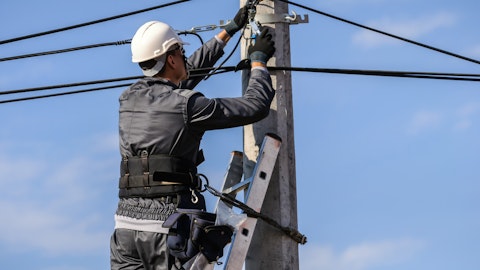Steven Nielsen: I think it’s primarily based on our experience. But I think when people set budgets, like they did last year, and then for whatever reason, rates increase more than maybe some expected or certainly was at the higher range of expectations, so that makes a tougher year. I think in those — in that climate, Avi, if you have better weather and you get a little bit ahead of budget, you probably have to work yourself back to the budget line just because costs are a little bit higher on the capital side. I think — in the current environment, I think people have a good handle on how to budget. I think they’re expecting less volatility around cost of capital, and so I think there’s more confidence as they move into next year as they execute their plans.
Now there’s no guarantees. But I think when we highlighted this issue last year, I think we more or less had a view that was borne out by how the year played out, and we’re feeling good about the view that we have now.
Avi Jaroslawicz: Got it. Okay. Appreciate that. And then in terms of what you’re seeing in the supply chain and labor force, so — continued to call out limited equipment availability. Has that actually been a constraint on growth or a generalized risk statement? How should we think about that? And I guess also on your — how’s the ability to ramp up labor then?
Steven Nielsen: Yes. I think it’s a generalized risk. We have been — we have done a good job of managing through that risk, so I wouldn’t say that we’ve been constrained. That may not be true for everybody in our industry. And right now, as of the end of October, we have a little over $100 million worth of equipment on order, and we’ll be pleased when it comes in. And we continue to place new orders so that we can support the growth in the business that we see.
Operator: Our next question will come from Alan Mitrani from Sylvan Lake Asset Management.
Alan Mitrani: Can you give us a sense of where CapEx will be in the next — for the rest of the year and into next year? Gross and net?
Steven Nielsen: Yes. Alan, on a gross basis, it was a little over $60 million in the quarter. Now we had a good quarter for proceeds, so it was less than we expected on a net basis. It’s a little bit hard for us to forecast based on timing. We have a lot on order. But I would say, Alan, it’s probably somewhat less than what our original expectation was for the year not because we don’t need it, but we’re taking it in as quickly as we can get it.
Alan Mitrani: And where do you think gross CapEx could be for the next year in terms of growth? And how much spend you might need to upgrade some of their CapEx?
Steven Nielsen: Yes. I don’t see anything beyond what our historical relationships have been. If we can grow faster, we’ll buy more.
Alan Mitrani: Can you talk about — you seem very confident about the government programs, I guess, that are coming in finally after the normal bureaucratic delays. Is that what’s lending, giving you a lot of confidence in terms of the outlook going forward? Besides the customers, obviously, getting used to the cost of capital and just sort of adjusting.
Steven Nielsen: I mean, Alan, I think what I’d start with is we have the impacts of earlier vintage federal programs that are impacting the business today such as RDOF, ARPA and CARES Act. We have state broadband funds that are separate and apart from federal dollars that are in the business, and so we continue to see — we see BEAD and other programs as a continuation of an increasing trend, not necessarily as a new trend in and of themselves. I mean, this is a big movement. There’s lots of capital being deployed. Sometimes, we’ll work for customers where a single project will have a state funding source and a federal RDOF source. And in fact, 1 of our customers just relayed on a recent earnings call that above and beyond what they had originally identified for eligible passings, which for this customer was about 1.1 million for RDOF, they had found [300,000] adjacent passings that were enabled by the RDOF program.
So I don’t know if you call that federal, state, private capital, it just is up and to the right for rural broadband.
Alan Mitrani: Are you able to tell how much of your current revenues or incremental revenues are related to some of these programs? Or does it come through just general MSAs and other work so it’s hard to tell?
Steven Nielsen: It’s a mix, Adam — excuse me, Alan. It’s a mix. Some we can see. Some of the customers won’t tell us, and we’ll just see it flow through the actual MSA that we have with that customer.
Operator: And I am showing no further questions from the phone lines. I’d now like to turn the conference back over to Steven Nielsen for any closing remarks.




